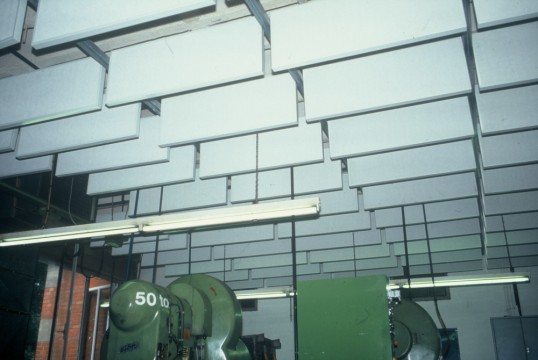- Artificial Intelligence (AI)
- Occupational exposure limit values
- Climate Change and Occupational Safety
- List of CMR substances
- Electromagnetic fields
- Ergonomics
- EU GHS Regulation
- Industrial Security
- Collaborative robots
- Noise
- Nanoparticles at the workplace
- Optische Strahlung
- REACH
- Reference materials
- Proficiency testing
- Vibration
- Virtual reality
- Work 4.0
Noise abatement by room acoustic measures

Noise-absorbing baffle ceiling in a stamping shop
Source: IFA
Noise exposure in workspaces consists of sound emitted directly from machinery and equipment and that reflected by walls and ceilings. Ceiling and/or wall surfaces designed to absorb sound, reduce the reflected sound component, resulting in a reduction in noise for the workplaces concerned. These room acoustic measures can be used to advantage in many companies. Attention should be paid to room acoustics particularly during the planning of new workplaces, since a sound-absorbing retrofit of a room is usually much more costly.
The German Noise and Vibrations Occupational Safety and Health Ordinance (LärmVibrationsArbSchV) requires workspaces to be designed such that the sound propagation conditions correspond to the state of the art. The technical rules governing noise pursuant to the above mentioned ordinance specifie these requirements in the form of room-acoustic characteristic values. The state of the art can be considered complied with when:
-
The mean sound absorption coefficient ᾱ is at least 0.3 in each of the octave bands with centre frequencies of 500 to 4000 Hz
Or: - The rate of spatial decay of sound pressure levels per distance doubling DL2 in the distance range of 0.75 to 6 m is at least 4 dB in the octave bands with centre frequencies of 500 to 4000 Hz .
Smaller workspaces should preferably be designed on the basis of the sound absorption coefficient, larger workspaces on the basis of the sound level reduction. At workspace volumes of between 1,000 and 10,000 m2, the decision should be made on a case-by-case basis. Since the costs entailed by room acoustic measures and the absorption materials used may be high, the material should be used selectively and only in the quantities actually required. For this purpose, forecast calculations are required for different room acoustic variants that enable the requirements of the ordinance to be satisfied by an iterative approach. The IFA uses a software application in accordance with the VDI 3760 standard for this purpose.
Since the efficacy of room-acoustic measures in an existing workspace is dictated substantially by the situation as-is, a precise analysis must be performed of the existing room acoustics. Depending on the existing situation, noise reductions of approximately 1 to 6 dB(A) can be attained in the vicinity of machines, and of 10 dB(A) and more at greater distances from the sources of noise. In workspaces in which the noise exposure is caused by the workers' conversations, as for example in call centres or classrooms, noise reductions in the region of 8 dB(A) can often be attained.
Further information on the acoustic design of workspaces can be found in noise protection worksheet IFA-LSA 01-234, which describes room acoustics in industrial workspaces and the associated requirements, principles, measurement methods, measures, and the efficacy of noise control.
Regulations available for download:

Download
